- Home
- About the Journal
- Peer Review
- Editorial Board
- For Authors
- Reviewer Recognition
- Archive
- Contact
- Impressum
- EWG e.V.
An important task of gerontology and lymphology is to improve the function of the lymph nodes and reduce the risk of polymorbidity. In our experiment, we have shown the possibility of phytonutrient control over the lymph node work by changing of structure and trace-element profile. The purpose of the work is to assess the effect of a phytocomposition on the rate of aging of somatic lymph node by characterizing the structure and trace elements.
Materials and Methods: The experiment was performed on Wistar rats with conditional division into old and young animals. Half of old animals received bioactive phytocomposition. The method of X-ray fluorescence analysis using synchrotron radiation (RFA SR) was used to determine trace elements (Mn, Fe, Cu, Zn, Se) in the inguinal lymph node. Results: Aging leads to immune failure accompanied by destabilization of compartments and trace element deficiency. Phytonutrient delivery format (flavonoids and trace elements) in the form of a plant food supplement helps to delay the onset of lymph node aging and improving trace element status. We have indicated the significant contribution of trace elements in restoring the work of the lymph node based on the total intensity coefficient of age changes. Conclusion: Phytonutrients improve functioning of the lymph node in aging. Thus, they can be employed as prospective anti-aging compounds in medical and wellness programs.
Keywords: lymph nodes, trace elements, gerontology, phytonutrients, phytocorrection
The problem of aging and the quality of life of older people remains relevant and makes it necessary to search for new anti-aging strategies in preventive gerontology and lymphology [1, 2]. The phenomenon of the lymphatic system manifests itself in the dynamic provision of immune potential and endoecological safety of organs on the territorial principle at different periods of life. It is necessary to implement the idea of management of lymphatic system work when using lymphotropic technologies of restorative medicine [1, 3].
The most promising direction of the study is the possibility of slowing down age changes in lymphatic (lymphoid) systems. Phytotherapy helps to achieve an antiaging effect in lymphoid tissue [1, 4]. The correction should target peripheral lymphoid organs, including their structure (compartments) and trace elements. This enables to study the feasibility of using phytonutrients for correction of age-induced changes.
The purpose of the work is to assess the effect of a phytocomposition on the rate of aging of somatic lymph node by characterizing structure and trace elements.
The experiment was performed on 160 white Wistar rats with conditional division into an experimental group (old, rat age is 18-20 months) and a control group (young, rat age is 3–5 months). The age of young animals was taken into the basic period when lymphoid tissue has the greatest development. The age of old animals corresponds to the final period when the greatest senile organ changes are found. This is done for comparative dynamic evaluation of lymph nodes. We worked with animals in accordance with international regulations (European Communities Council Directives of 24 November 1986, 86/609/EEC and Order No. 267 of the Ministry of Health of the Russian Federation of 19.06.2003).
The animals were maintained at the standard vivarium conditions. Half of old animals received a bioactive phytocomposition. It included crushed medicinal plants of Siberia (badan, rhodiola pink, hedysarum, blueberries, currants, rosehips, etc.) [1, 3, 4]. The analogue of the phytocomposition is the bioactive supplement "Lymphophyte" of the series "Harmony Vita" (Novosibirsk, Russia). The main bioactive phytonutrients are flavonoids complex and bioelements. The flavonoid complex contained derivatives of catechins, flavanols, anthocyanes, anthocyanidins, and others. The definition of flavonolglycosides in the recalculation to rutinum served as confirmation of its authenticity as the supplement. Bioelements (manganese, zinc, copper, selenium, iron) refer to essential elements. Trace elements in the form of ions and compounds with proteins, enzymes are actively involved in metabolism and in the work of the immune system. The benefit of phytonutrients depends on the delivery format (food ingredient or food supplement). The daily dose of phytocomposition is 0.1-0.2 g/kg, it was added for a month to animal feed.
The subject of the study was the somatic inguinal lymph node. The following methods were used in the work: The histological method was used to prepare lymph node sections. They were colored with hematoxylin and eosine, a trichromic dye for morphometry of intranodular structures in the ImagePro program. The method of X-ray fluorescence analysis using synchrotron radiation (RFA SR) was applied to determine trace elements of antioxidant and immune type (Mn, Fe, Cu, Zn, Se) in the lymph nodes. We used the equipment of the G.I. Budker’s Institute of Nuclear Physics, Novosibirsk [5].
Mean arithmetic (M), error (± m) and validity of differences at p < 0.05 were determined by StatPlus Pro 2009, AnalystSoft Inc. Statistical analysis of dynamicity of data rows of initial and final age period were carried out additionally. The following indicators were defined:
absolute increase or decrease (Dy) in a unit of time characterizes the speed and direction of the process. Absolute gain (decline) is defined as the difference between the base and final levels; the sign "+" characterizes the increase, or the sign "-" is the decrease;
coefficient or rate of growth (or decline) (Cg; Rg% as a percentage) is calculated as a coefficient of subsequent level to previous, can be expressed as a percentage. This factor shows the process intensity;
the rate of increase or decline (Ri) characterizes the magnitude of increase or decline in relative values (in%) and it is defined as the percentage of absolute gain or decline to the previous level of rows; the sign "+" is the increase or the sign "-" is the decline.
The inguinal lymph node refers to a somatic mixed type. The inguinal lymph node drains limbs and genital region. The lymph node performs an actively drainage function due to the high motor activity of limbs during all periods of life. With age, this function of the lymph node weakens, reflecting the regional specificity of aging in accordance with the concepts of the lymphatic region [1] and lymphosome [6]. The equivalent of adequate lymph node working is the unity of two interrelated functional systems, including structural organization (compartments) and trace-element status.
Aging. In aging dynamics, there is an uneven change in intranodular compartments with different intensity. This is evidenced by base indicators characterizing the final results of all changes in lymph node structures compared to the baseline. Indicators dynamics are different and show the ambiguity of compartmentalization in aging. We have identified two trends (Fig. 1). First, there is a different intensity absolute increase in capsule, cortical plateau, paracortex and medullary substances structures of a lymph node for the observed period. Second, in aging, there is an absolute decrease of subcapsular sinus and lymphoid follicles. The coefficient of growth shows similar patterns. This factor shows the intensity of changes through the ratio of the final and base levels of rows. Compartment sizes are associated with proliferation of lymphoid cells and sparing of their zonal density. And this, in turn, depends on the state of the bioelement status. Trace element balance and cell proliferation suffer from aging (Fig. 2). There is an absolute decrease in Se, Cu, Zn and Fe concentrations. Most trace elements are in deficiency except for manganese. The growth coefficient is less than one for Fe, Cu, Zn and Se, the one is 0.72 to 0.83, showing a lag from the baseline. The fact of bioelement deficiency is pathogenetically related to the structural organization of the lymph node. Age-induced changes affect cells and their microenvironment, compartments in the lymph node, bioelement exchange, reducing its workability [7-10] and reflecting the regional specificity of aging [1].
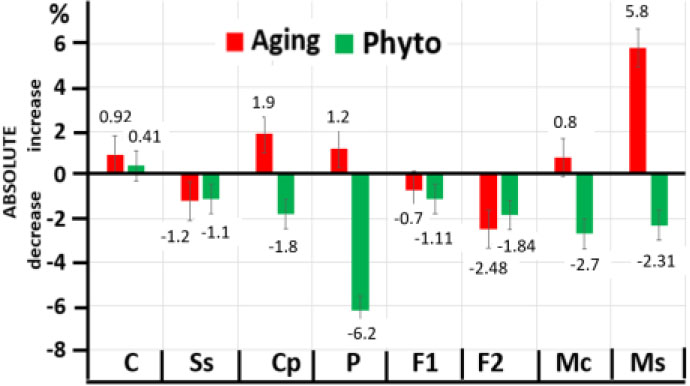
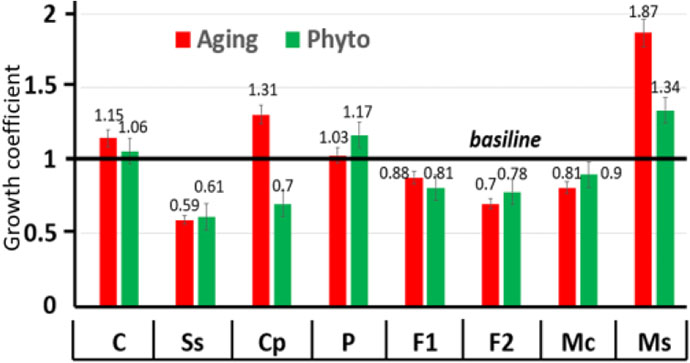
Fig. 1. Absolute increase or decrease
(on the left) and growth coefficient (on the right) for inguinal lymph node structures
in aging and after phytocorrection.
С – capsule; Cp – cortical
plateau; P – paracortex; F1 – premary lymphoid follicles; F2
– secondary lymphoid follicles;
Mc – medullary cords;
Ms – medullary lymphatic sinus
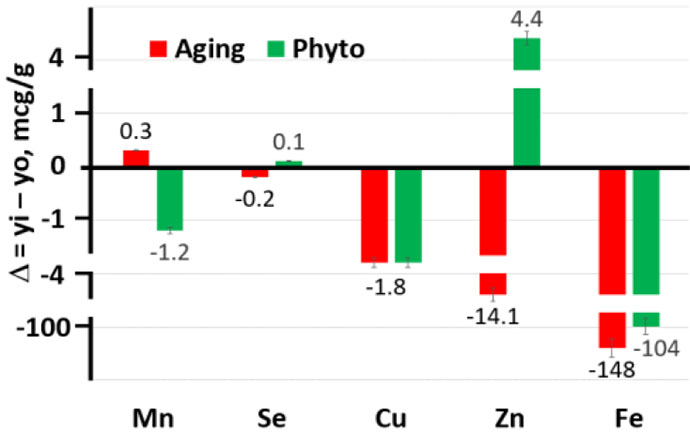
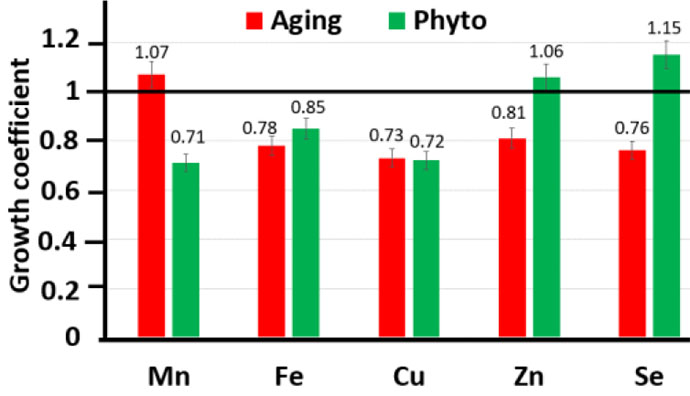
Fig. 2. Absolute increase or decrease (on the left) and growth coefficient (on the right) of trace elements concentration in the inguinal lymph node at aging and after phytocorrection
Phytocorrection. Taking phytonutrients changes the speed and intensity of lymph node aging. We identified a difference between the size of lymph node structures in aging and after phytonutrient support in the analysis of dynamic rows indicators (Fig. 1). It is noted that the intensity of changes in structures decreases after taking phytocomposition, and the rate of absolute increase changes by the rate of absolute decrease and becomes closer to the initial level. This is typical of the cortical plateau, paracortex, medullary substance structures. In other cases, there is generally an approximation of the compartment area to the baseline after phytocorrection (Fig. 1). It is true, that the dimensions of structural and functional zones do not permanently reach initial values. Evidence of this is the magnitude of the growth coefficient. The noted pattern indicates the modifying effect of phytonutrients (flavonoids) and the slowing down of age-induced lymph node transformation.
The intake of bioelements in the phytocomposition alters the deficient trace-element profile of the lymph node that has undergone senile changes. Medicinal plants are rich in trace elements and can make up for deficiency in the organism [3, 4]. After taking of the phytocomposition, the growth coefficient exceeds one with relation to trace elements Zn, Se, exceeding the base level (Fig. 2). The increase rate of zinc and selenium biolements was 106% and 115%, respectively. The amount of excess manganese decreases after phytocorrection. The increase rate was 71-72% for Mn and Cu, 84% for Fe. The new bioelements profile has a positive effect on the cellular-structural organization of the lymph node. Lymph node functional activity is maintained to provide natural intracorporeal detoxification at lymphatic region level.
The calculation-analytical evaluation allows characterizing the ability of the lymph node to perform functions. The synchronous work of two functional systems (comartments and trace elements) depends on the viability of adaptation-compensatory mechanisms that counteract lymph node aging. Aging results in impaired function of the lymphatic system. This fact represents the total growth coefficient (Fig. 3).
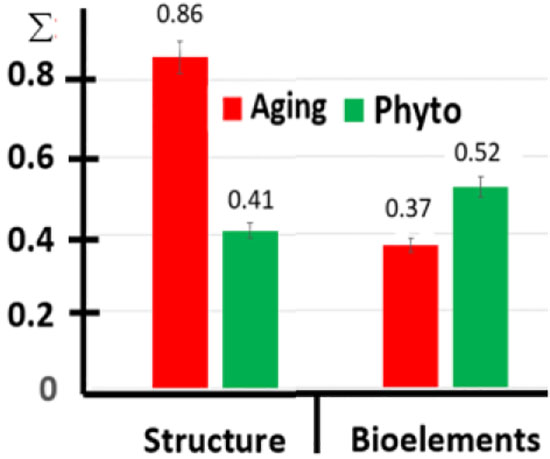
Fig 3. Total growth coefficient of the inguinal lymph node. Evaluation of the intensity of changes in the functional system, including the structure and trace elements of the lymph node in aging and after phytocorrection
Trace element deficiency is pathogenetically associated with destabilization of lymph node structure [1, 2]. There is a decrease in drainage and protective functions of the lymph node. This is a destabilizing factor, which increases the risk of developing a pathological condition [10]. Improving lymph node function is a primary task of gerontology and lymphology [1]. We proposed an original phytocomposition. Phytonutrients (flavonoids, trace elements) slow down the intensity of aging by compartments and overcome the deficiency of bioelements. The value of the total coefficient proves and indicates the significant contribution of trace elements to the restoration structure and workability of lymph node. There is a direct or indirect link between trace elements and enzymes involved in lymphoid cell proliferation and compartmental formation. The effect of phytonutrients (flavoids, bioelements) is achieved by enhancing lymphoproliferation, waxing the size of compartments [8, 9]. Phytonutrients have geronto-protective properties and provide reliability of lymph node work.
Combating the ageing of organs and systems is an essential task. Its solution is related to the integration of gerontology and lymphology. Phytonutrients (flavonoids, bioelements) in the composition of plants take a special place. Phytonutrients influence the functional components of the lymph node, including its structure and trace element exchange. Calculation-analytical evaluation showed that phytocorrection changes the rate and intensity of lymph node changes in aging. There is a modifying effect on lymph node structures with an increase in trace elements concentration. Phytotherapy have a positive effect on age-dependent changes in the lymph node, it enables increasing its reliability and a non-specific resistance.
The state task of research work No FWNR-2022-0012. The work was performed on the equipment of Budker’s Institute of Nuclear Physics SB RAS (Novosibirsk), using the equipment supported by project RFMEFI62119X0022 [5].